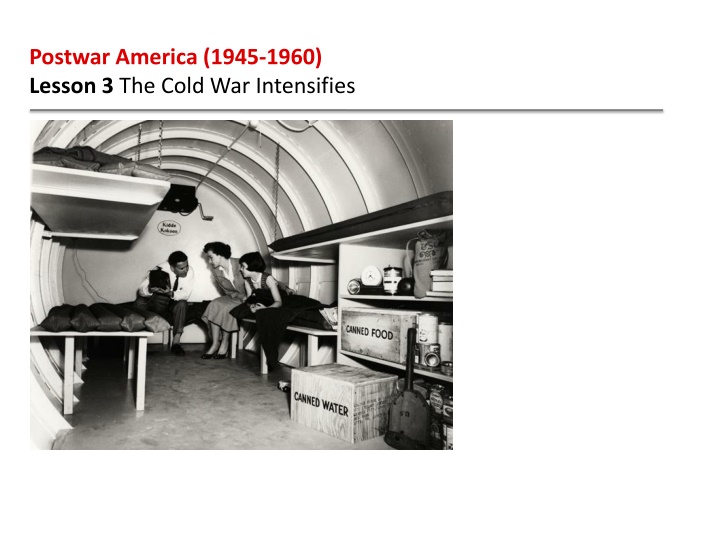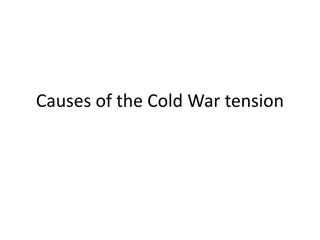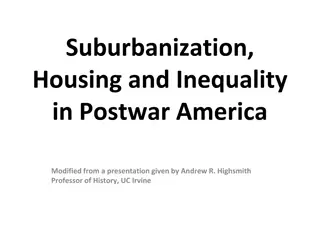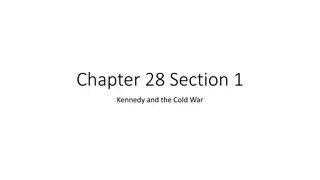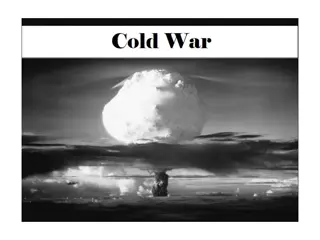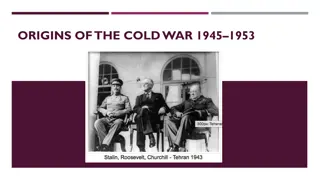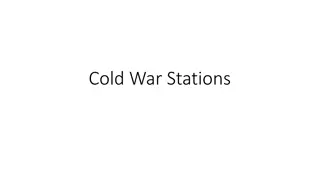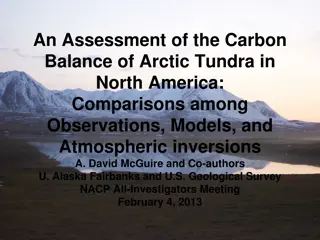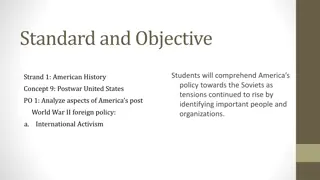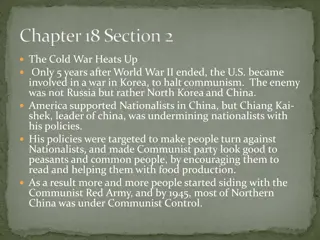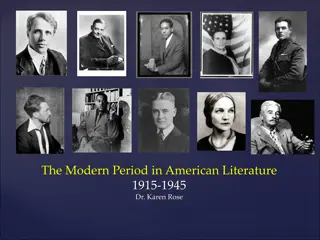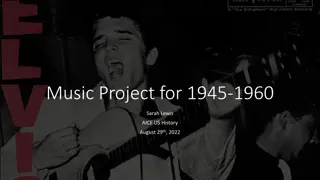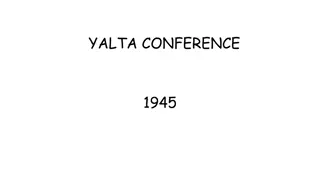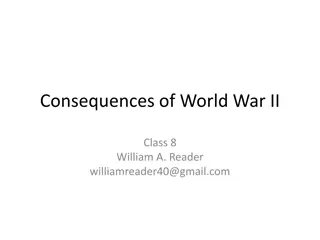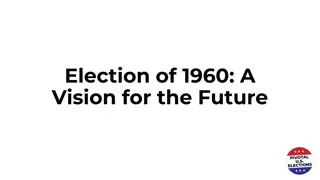The Cold War Escalates: Postwar America 1945-1960 Lesson 3
The period after World War II saw tensions intensify between the United States and the Soviet Union, leading to a global struggle for influence. The arms race, the space race, and significant international conflicts all heightened Cold War tensions. President Eisenhower's response to communism differed from Truman's approach, with policies like massive retaliation and brinkmanship shaping the era. The impact of these events on the United States, including the rise of nuclear bomb shelters, reflects the gravity of the Cold War era.
Download Presentation

Please find below an Image/Link to download the presentation.
The content on the website is provided AS IS for your information and personal use only. It may not be sold, licensed, or shared on other websites without obtaining consent from the author.If you encounter any issues during the download, it is possible that the publisher has removed the file from their server.
You are allowed to download the files provided on this website for personal or commercial use, subject to the condition that they are used lawfully. All files are the property of their respective owners.
The content on the website is provided AS IS for your information and personal use only. It may not be sold, licensed, or shared on other websites without obtaining consent from the author.
E N D
Presentation Transcript
Postwar America (1945-1960) Lesson 3 The Cold War Intensifies
Postwar America (1945-1960) Lesson 3 The Cold War Intensifies Learning Objectives Describe how Cold War tensions were intensified by the arms race between the United States and the Soviet Union. Explain how Eisenhower s response to communism differed from that of Truman. Analyze the impact on the United States of significant international Cold War conflicts. Describe how Cold War tensions were intensified by the space race.
Postwar America (1945-1960) Lesson 3 The Cold War Intensifies Key Terms mutually assured destruction John Foster Dulles massive retaliation brinkmanship Nikita Khrushchev nationalized Suez crisis Eisenhower Doctrine Central Intelligence Agency (CIA) National Aeronautics and Space Administration (NASA)
The Arms Race Intensifies Tensions By 1950, the United States and the Soviet Union were, by far, the two most powerful nations in the world. The conflicting ideologies and goals of these rival nations led to a worldwide struggle for influence. The policies followed by the two superpowers would help shape the history of the 20th century for much of the world, from Latin America to the Middle East.
The Arms Race Intensifies Tensions Cold War Worries Rise The Arms Race Speeds Up
The Arms Race Intensifies Tensions In the 1950s, personal nuclear bomb shelters became popular throughout the United States. They were equipped with beds, food, and other necessities designed to help a family survive a nuclear attack.
Eisenhowers Response to Soviet Aggression President Dwight Eisenhower knew firsthand the horrors of war and the need to defend democracy. He had led the World War II Allied invasions of North Africa, Italy, and Normandy. Having worked with top military and political leaders during the war, he was capable of speaking the language of both.
Eisenhowers Response to Soviet Aggression Eisenhower s Policies toward Communism Stalin s Death Eases Tensions
Eisenhowers Response to Soviet Aggression Like Truman, President Eisenhower (left) and his Secretary of State, John Foster Dulles (right), believed that the containment of communism was essential to U.S. foreign policy.
Eisenhowers Response to Soviet Aggression Analyze Data How does the data shown in the infographic illustrate Eisenhower s approach to defense spending?
International Cold War Conflicts Peaceful co-existence was easier to imagine than it was to practice. The United States and the Soviet Union remained deeply divided. The Soviet Union would not allow free elections in the areas it controlled, and it continued to attempt to spread communism around the world. Dulles talked about rolling back communism and liberating the countries under Soviet rule.
International Cold War Conflicts Uprisings Behind the Iron Curtain: Poland and Hungary The Suez Crisis The Eisenhower Doctrine The Space Race Increases Tensions
International Cold War Conflicts In 1956, Poland revolted against Soviet rule. Here, the crowd carries a Polish flag during an anti- communist demonstration.
International Cold War Conflicts Analyze Maps The Suez Canal connects the Mediterranean Sea and the Red Sea. Why was the canal so strategically important?
Quiz: The Arms Race Intensifies Tensions Which Cold War event first suggested that Soviet military power might be on par with that of the United States? A. The Soviet Union established the policy of brinkmanship. B. The Soviet Union launched a satellite into an orbit of Earth C. The U.S. discovered that the Soviet Union had set off an atomic bomb. D. The U.S. learned that the Soviet Union had developed a hydrogen bomb.
Quiz: Eisenhowers Response to Soviet Aggression Which term describes John Foster Dulles threat to use extreme force in response to communist aggression? A. the space race B. the domino effect C. massive retaliation D. mutually assured destruction
Quiz: International Cold War Conflicts How did President Eisenhower respond to the Suez Crisis? A. He supported Europe s effort to seize control of the Suez Canal. B. He consulted with Nasser and resolved to send military aid to Egypt. C. He offered to fund Nasser s project to construct a dam on the Nile River. D. He criticized Britain and France and refused to supply them with U.S. oil.
